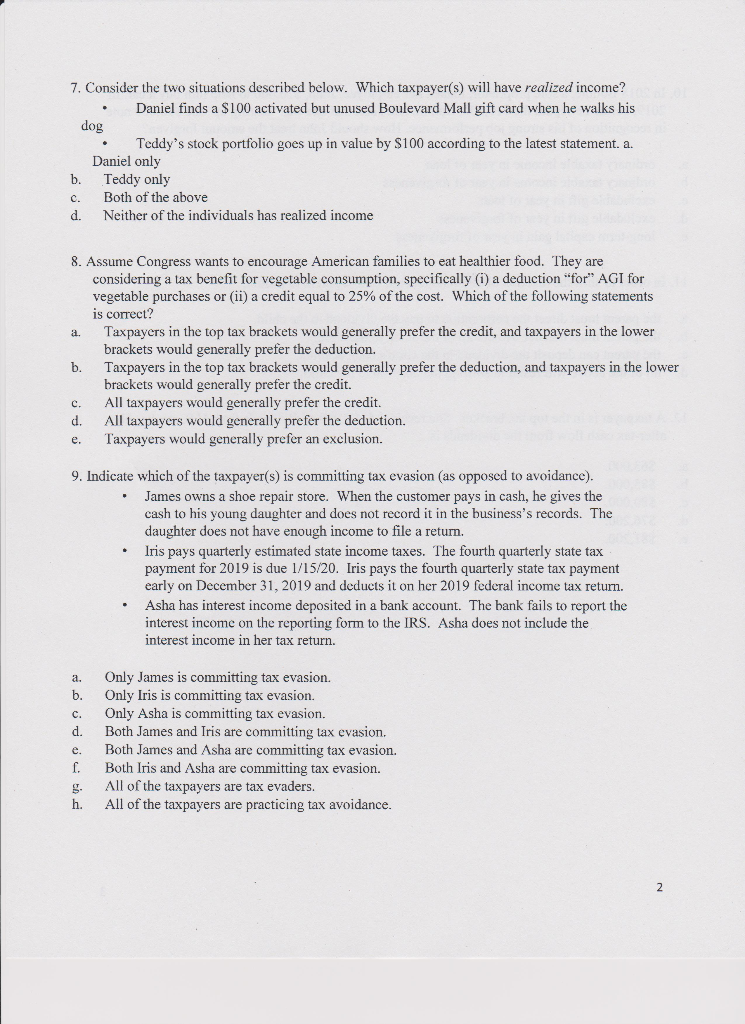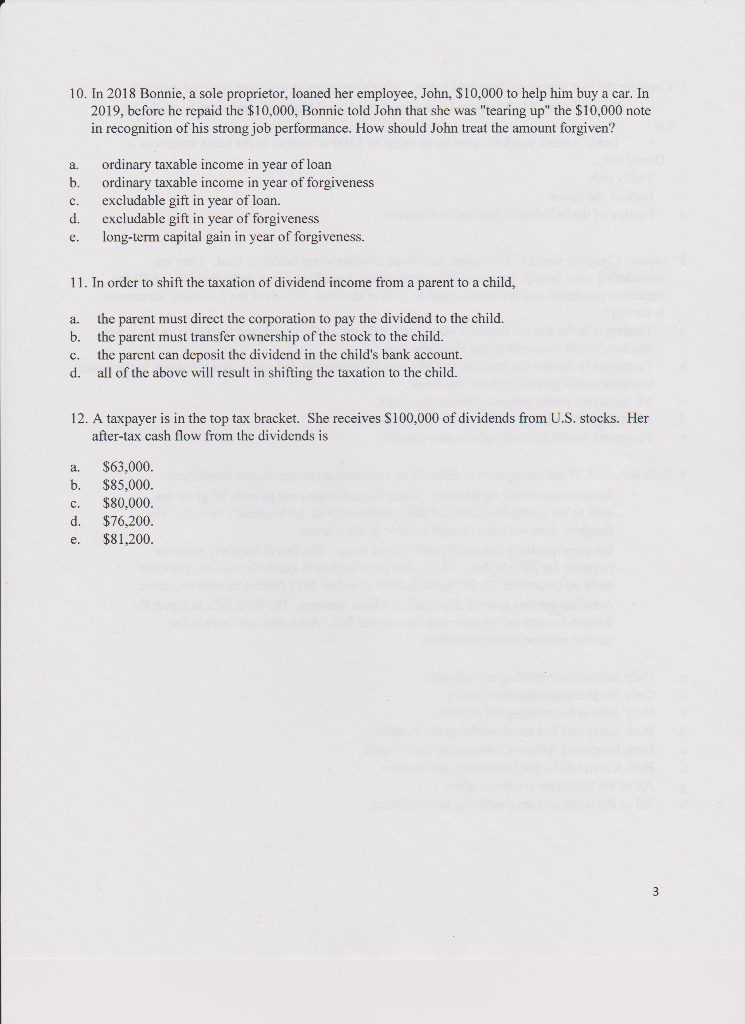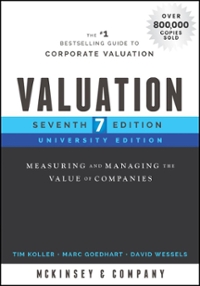Tax Questions applying 2019 US Tax Would really appreciate if you can also show the work or explanation. Thank you! 

7. Consider the two situations described below. Which taxpayer(s) will have realized income? Daniel finds a $100 activated but unused Boulevard Mall gift card when he walks his dog Teddy's stock portfolio goes up in value by $100 according to the latest statement. a. Daniel only b. Teddy only c. Both of the above d. Neither of the individuals has realized income 8. Assume Congress wants to encourage American families to eat healthier food. They are considering a tax benefit for vegetable consumption, specifically (i) a deduction "for" AGI for vegetable purchases or (ii) a credit equal to 25% of the cost. Which of the following statements is correct? a. Taxpayers in the top tax brackets would generally prefer the credit, and taxpayers in the lower brackets would generally prefer the deduction. Taxpayers in the top tax brackets would generally prefer the deduction, and taxpayers in the lower brackets would generally prefer the credit. c. All taxpayers would generally prefer the credit. d. All taxpayers would generally prefer the deduction. e. Taxpayers would generally prefer an exclusion. 9. Indicate which of the taxpayer(s) is committing tax evasion (as opposed to avoidance). James owns a shoe repair store. When the customer pays in cash, he gives the cash to his young daughter and does not record it in the business's records. The daughter does not have enough income to file a return. Iris pays quarterly estimated state income taxes. The fourth quarterly state tax payment for 2019 is due 1/15/20. Iris pays the fourth quarterly state tax payment early on December 31, 2019 and deducts it on her 2019 federal income tax return. Asha has interest income deposited in a bank account. The bank fails to report the interest income on the reporting form to the IRS. Asha does not include the interest income in her tax return. b. Only James is committing tax evasion. Only Iris is committing tax evasion. Only Asha is committing tax evasion. Both James and Iris are committing tax evasion. Both James and Asha are committing tax evasion. Both Iris and Asha are committing tax evasion. All of the taxpayers are tax evaders. . All of the taxpayers are practicing tax avoidance. h. 10. In 2018 Bonnie, a sole proprietor, loaned her employee, John, $10,000 to help him buy a car. In 2019, before he repaid the $10,000, Bonnie told John that she was "tearing up the $10,000 note in recognition of his strong job performance. How should John treat the amount forgiven? b. c. d. e ordinary taxable income in year of loan ordinary taxable income in year of forgiveness excludable gift in year of loan. cxcludable gift in year of forgiveness long-term capital gain in year of forgiveness. 11. In order to shift the taxation of dividend income from a parent to a child, a. the parent must direct the corporation to pay the dividend to the child. b. the parent must transfer ownership of the stock to the child. c. the parent can deposit the dividend in the child's bank account. d. all of the above will result in shifting the taxation to the child. 12. A taxpayer is in the top tax bracket. She receives $100,000 of dividends from U.S. stocks. Her after-tax cash flow from the dividends is b. $63,000. $85,000. $80,000. $76,200. $81,200. e. 7. Consider the two situations described below. Which taxpayer(s) will have realized income? Daniel finds a $100 activated but unused Boulevard Mall gift card when he walks his dog Teddy's stock portfolio goes up in value by $100 according to the latest statement. a. Daniel only b. Teddy only c. Both of the above d. Neither of the individuals has realized income 8. Assume Congress wants to encourage American families to eat healthier food. They are considering a tax benefit for vegetable consumption, specifically (i) a deduction "for" AGI for vegetable purchases or (ii) a credit equal to 25% of the cost. Which of the following statements is correct? a. Taxpayers in the top tax brackets would generally prefer the credit, and taxpayers in the lower brackets would generally prefer the deduction. Taxpayers in the top tax brackets would generally prefer the deduction, and taxpayers in the lower brackets would generally prefer the credit. c. All taxpayers would generally prefer the credit. d. All taxpayers would generally prefer the deduction. e. Taxpayers would generally prefer an exclusion. 9. Indicate which of the taxpayer(s) is committing tax evasion (as opposed to avoidance). James owns a shoe repair store. When the customer pays in cash, he gives the cash to his young daughter and does not record it in the business's records. The daughter does not have enough income to file a return. Iris pays quarterly estimated state income taxes. The fourth quarterly state tax payment for 2019 is due 1/15/20. Iris pays the fourth quarterly state tax payment early on December 31, 2019 and deducts it on her 2019 federal income tax return. Asha has interest income deposited in a bank account. The bank fails to report the interest income on the reporting form to the IRS. Asha does not include the interest income in her tax return. b. Only James is committing tax evasion. Only Iris is committing tax evasion. Only Asha is committing tax evasion. Both James and Iris are committing tax evasion. Both James and Asha are committing tax evasion. Both Iris and Asha are committing tax evasion. All of the taxpayers are tax evaders. . All of the taxpayers are practicing tax avoidance. h. 10. In 2018 Bonnie, a sole proprietor, loaned her employee, John, $10,000 to help him buy a car. In 2019, before he repaid the $10,000, Bonnie told John that she was "tearing up the $10,000 note in recognition of his strong job performance. How should John treat the amount forgiven? b. c. d. e ordinary taxable income in year of loan ordinary taxable income in year of forgiveness excludable gift in year of loan. cxcludable gift in year of forgiveness long-term capital gain in year of forgiveness. 11. In order to shift the taxation of dividend income from a parent to a child, a. the parent must direct the corporation to pay the dividend to the child. b. the parent must transfer ownership of the stock to the child. c. the parent can deposit the dividend in the child's bank account. d. all of the above will result in shifting the taxation to the child. 12. A taxpayer is in the top tax bracket. She receives $100,000 of dividends from U.S. stocks. Her after-tax cash flow from the dividends is b. $63,000. $85,000. $80,000. $76,200. $81,200. e








